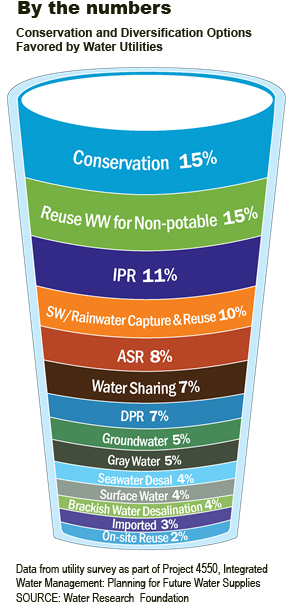Imagine a future in which the water industry doesn’t jump from crisis to crisis, reacting to each emergency as it happens; a future in which the industry has looked ahead and seen the totality of the water cycle and is prepared for a new era of constant change. Imagine a future that works — and even better — a future that might just already be here.
Just a few years ago, it seemed, water reuse couldn’t get past the “yuck factor.” Today, utilities in California and the Southwest have leapfrogged over the water reuse hurdle and are recycling water for potable distribution. San Diego’s Pure Water program, for example, could produce one-third of the city’s drinking water supply through water recycling by 2035.
Other states and cities are taking the lead in other arenas as well. In the past, neighboring agencies were often siloed and lacked means of collaboration to solve problems. But in Gwinnett County, Ga., multiple agencies worked together to consolidate hundreds of projects to serve more communities with fewer resources, saving millions of dollars. Chicago is using public-private partnerships to create a model for redefining the wastewater industry as an enterprise in resource recovery and environmental stewardship.
Philadelphia will invest $1.7 billion in capital projects in the next six years with its Green City, Clean Waters plan, building green infrastructure block by block to capture rain and snow and filter runoff before it flows into sewers. A green infrastructure program in New York City strives to reduce combined stormwater and sewage outflows into waterways downstream. And Portland, Ore., has been using a Stormwater Management Manual to protect water quality in rivers and streams, protect watershed health, and protect groundwater as a drinking water resource since 1999.
Finding non-traditional ways to meet our growing water needs used to seem like a pipe dream, but these dreams are becoming reality little by little every day.
“Uniting the World of Water,” the theme of this year’s American Water Works Association ACE15 conference in Anaheim, Calif., has never been more apt.
Instead of lurching from one dire situation to the next, water leaders are getting ahead of changing conditions and managing multiple challenges with proactive approaches. Challenges include climate change impacts like water shortages and catastrophic storms, the cumulative degradation of water quality, a growing population that doesn’t understand why using less water results in larger water bills, arcane water rights in many regions and a rising demand for lower-cost solutions.
Tackling these issues one by one is neither effective nor sustainable, and water planners are getting creative, transforming a fragmented view of water resources into a unified vision of coordinated conservation, resource protection and resource development. And it’s beginning to work.
 Brown and Caldwell Senior Engineer Lynn Williams should know. She’s spent the better part of a year studying more than 40 research reports surveying about 70 water agencies, and holding workshops with water leaders across the country as Co-Principal Investigator for WRF’s “Project 4550: Identifying Needs for Integrated Water Management.” She will present the project’s findings at ACE15 next week in a session called, “Integrated Water Management: What’s Next?”
Brown and Caldwell Senior Engineer Lynn Williams should know. She’s spent the better part of a year studying more than 40 research reports surveying about 70 water agencies, and holding workshops with water leaders across the country as Co-Principal Investigator for WRF’s “Project 4550: Identifying Needs for Integrated Water Management.” She will present the project’s findings at ACE15 next week in a session called, “Integrated Water Management: What’s Next?”
And guess what? She’s optimistic.
“Overwhelmingly, utilities said they felt confident that they will be able to handle their communities’ water needs in the future,” Williams said. “We are innovative and creative. We will evolve and adapt.”
“The main takeaway from Project 4550 was that the evolving challenges brought by climate change are really challenging us and driving new ways of thinking,” she said. “We’re learning to expect the unexpected, and to be prepared rather than surprised, developing new water sources and protecting the ones we already have.”
“The challenges no longer seem so overwhelming,” Williams said. Project 4550 will direct WRF’s research agenda for the new focus area on Integrated Water Management with new research projects already under way.
“The goal is to provide guidance to the water community on how to make the shift from what we’ve traditionally done to what is needed now,” Williams said. “We all have to realize that what we do in one area impacts others. We can’t manage individual resources in isolation from one another.”
The good news, she added, is that there are so many examples of places where integrated approaches and collaboration are taking place with the recognition that all stakeholders are involved in the same overall water cycle.
For example, the City of Los Angeles has launched plans to become a more sustainable city by adopting “One Water LA 2040” — a program that integrates all of the capital spending for drinking water, stormwater and wastewater into a single management plan.
The Bernalillo County Water Utility Authority in Albuquerque, N.M., is a great example of how water supply diversification can lead to more sustainable water supplies. Historically, the authority relied entirely on groundwater, depleting the aquifer at a rate of 1 to 3 feet per year. Realizing that sole reliance on the aquifer was not sustainable, they implemented a Water Resources Management Strategy that combines rate increases, conservation measures, reuse and reclamation projects and a transition to a surface water supply. Thanks to this strategy, the aquifer has risen as much as 10 feet since 2008 and it’s still rebounding.
Gwinnett County, Ga., coordinated 400 projects and sub-projects in a $1.8 billion program to keep its water and wastewater infrastructure ahead of booming population growth. Instead of taking on each project piecemeal, looking at the big picture and consolidating resources allowed the county to save nearly $80 million and, in the end, serve more communities with fewer facilities.
ACE15 is overflowing with more examples like these. From how California’s water agencies are responding to the drought, to water main rehabilitation in Baltimore’s congested urban environment, to an off-peak pumped reservoir as a regional water supply in metro Atlanta. These projects illustrate what “Uniting the World of Water” means for today’s water professionals.
“AWWA’s Total Water Solutions initiative recognizes that the municipal water cycle is more interconnected,” says David B. LaFrance, CEO of AWWA. “Much of the ACE15 program showcases how today’s water professionals grasp the total water picture and are developing comprehensive, effective solutions not just for the future, but right now.”

